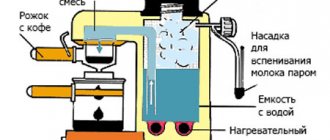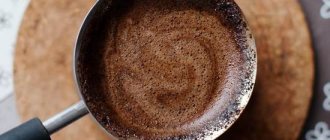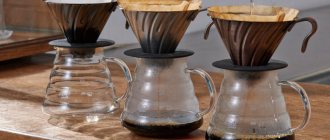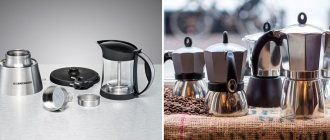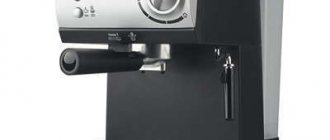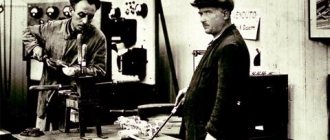Almost every person cannot imagine his morning without a cup of invigorating, aromatic and tasty coffee. It would seem that only professionals in coffee shops, coffee bars and similar establishments can prepare such a drink correctly. But with the advent of coffee machines, making coffee has become a common home procedure for many coffee lovers. One of the popular types of such equipment is a carob coffee maker. What does the process of making coffee in a carob coffee maker look like and what kinds of drinks can be prepared using such a machine?
History of the carob coffee maker
The prototype of espresso coffee makers was a compression-type machine created by the Frenchman Edouard Loisel de Santé in the 19th century. In 1901, Italian engineer Luigi Bezzera received a patent for a coffee machine that very quickly prepared rich and strong coffee.
Bezzera did not engage in production and in 1903 sold his patent to industrialist Desiderio Pavoni, who 2 years later began producing coffee machines. However, due to a design flaw, the coffee grounds in them overheated, resulting in bitter coffee.
Pavoni's commercial success did not go unnoticed, and soon several more companies began producing coffee machines. Over the next 50 years, large companies were founded that still exist today:
- Simonelli (Italy) – produces medium and high performance espresso machines;
- Faema (Italy);
- Gaggia (Italy) - currently purchased by Philips as part of the Saeco company;
- JURA Elektroapparate AG (Switzerland).
The optimal parameters of a coffee machine for making espresso were determined experimentally:
- pressure in the working chamber is about 9 bar;
- water temperature ranges from 86 to 93 ºС.
Coffee maker Gaggia 1948 goals
The founder of Gaggia, Giovanni Achille Gaggia, managed to create technology that improved the quality of espresso. Gaggia patented the use of a screw piston to force water through pressed coffee powder. Contact with steam was eliminated, and the bitterness that appeared due to high temperature was removed from the taste of espresso. So-called lever (piston) coffee makers can still be found in cafes and bars, although automatic and super-automatic machines are now in service.
In the second half of the 20th century, the dimensions of coffee machines decreased significantly; coffee makers appeared not only for catering establishments, but also for the home. When designing new devices, electric heat exchangers, rotary pumps, and an internally heated cooking chamber were used. The predecessors to modern home espresso machines were released in 1961:
- "Elektra Micro Casa a Leva";
- "La Pavoni Europiccola".
In 1964, the La Pavoni Professional Lever coffee maker, specially designed for home use, went on sale.
Anti-scale products
Cleaning products for the care of coffee makers are divided into several groups. The following types are particularly effective:
- Chemical cleaners.
- Softener filters.
- Decalcifiers.
Chemical
These products contain various acids. They are allowed for models coated in plastic, glass or steel. The substances are highly effective, but can negatively affect built-in automation and rubber seals.
Chemicals contain various acids.
Softening filters
They are distinguished by their ability to reduce water hardness, preventing the accumulation of plaque. After use, magnesium and calcium ions turn into sediment and do not interact with the heater.
Decalcifiers
There are 2 types of decalcifiers available for sale that can be used to clean the coffee maker:
- Pills. They are a mixture of chemical components that are compressed into a single substance for easy use.
- Liquid formulations. The cleaner dissolves instantly and does not contain any solid particles that may remain inside the machine.
Decalcifiers can be used to clean your coffee maker.
Modern carob-type coffee makers
Progress does not stand still; every day new manufacturers and more and more advanced models appear, possessing a set of additional functions:
- cappuccino machine - a device for frothing milk foam;
- platform for heating cups;
- function of pre-wetting coffee powder;
- in coffee machines - a built-in coffee grinder and processor for executing various programs, including recipes for coffee drinks, self-cleaning and descaling procedures.
How does an espresso coffee maker work?
Horn coffee makers get their name from the resemblance of the filter holder to the coffee horn. In these devices, steam or hot water is pressurized through a filter with tiny holes filled with compacted coffee powder. The hot drink is collected in a container placed under the filter.
To prepare coffee drinks with milk, coffee makers are equipped with cappuccino makers - devices for frothing milk into foam. A cappuccino maker is a tube that supplies steam to a container of milk. At the end of the tube there is a plastic nozzle with three holes, designed to intensively froth milk with jets of steam under pressure.
Factors that affect the taste of espresso:
- variety, degree of roasting and grinding of coffee beans;
- temperature of water supplied for extraction;
- the pressure that develops in the working chamber.
What is cappuccino?
Previously, cappuccino was a strong coffee to which milk was simply added to hide the expensive product from prying eyes. But over time, the recipe has been greatly modernized, and today you can try a very tasty and delicate cappuccino in any coffee shop or even in an ordinary cafe. The modern cappuccino recipe is hot milk whipped into a thick, dense foam that covers freshly prepared espresso.
You can try cappuccino not only in some specialized establishment. Sometimes it is enough to know the recipe for this delicious drink to prepare it at home using those methods and methods that are available to everyone.
Types of carob coffee makers and coffee machines
Based on the operating principle, carob coffee makers are divided into 2 groups:
- steam;
- pump-action
Features of steam coffee machines
Steam coffee makers, or Steam-Espresso, are much cheaper than pump coffee makers, but the quality of the drink differs in strength and taste.
The steam generated as a result of boiling water in the tank, when a pressure reaches 4–5 bar, opens the valve and enters the working chamber (inside the filter holder). Then the steam passes through a compressed tablet of ground coffee, then the condensate flows into a cup placed in advance. The drink may taste bitter because the steam temperature is too high, and due to the low pressure (below 9 bar), the contact of the coffee grounds with the steam lasts quite a long time.
Steam-Espresso example
It is difficult to obtain classic espresso in a steam coffee maker; the result in consistency and taste is closer to lungo, although the caffeine content will be high.
Advantages:
- steam coffee makers are cheaper than pump coffee makers;
- do not create noise during operation;
- The drink turns out to be invigorating.
Flaws:
- Preparing a cup of coffee takes longer than with a pump coffee maker;
- The drink turns out a little watery.
Features of pump coffee makers
Pump-type coffee makers (also called Pump-Espresso) are considered a better option than steam ones. Pump coffee makers are equipped with an electromagnetic pump that drives water through a thermoblock. In the boiler, the water is heated to a temperature no higher than +93 ºС, creating high pressure, which in the filter can reach up to 10, and in some models – up to 15 bar.
Pump-Espresso
Drinks prepared in Pump-Espresso coffee makers are better, and the taste of the coffee beans is revealed more fully.
Advantages:
- the drink is rich, without particles of grounds;
- a lush coffee foam (cream) is formed;
- preparing a cup of coffee takes 20-30 seconds;
- the taste lacks sourness and bitterness.
Flaws:
- the pump pump is noisy;
- quite high price.
Principle of operation
Unlike most mechanisms in which coffee is mixed with water, a carob coffee machine has a completely different operating principle.
In devices of this type, hot water or steam under pressure passes through compressed ground coffee, absorbing maximum taste and aroma, after which it condenses in a special chamber, turning into a drink.
There are two types of such coffee makers:
- Pump-action . It heats the water to 95 degrees, after which it is forced through a coffee horn under a pressure of 15 bar. This method allows you to preserve the nutrients and aroma of coffee. The device handles one cup of coffee in about a minute and a half.
- Steam . It differs from the pump type in the degree of heating, pressure and method of water supply. Water in a closed tank is heated to boiling and steam formation. When the pressure in the tank reaches 4 bar, the valve opens and steam flows through the coffee in the cone. Coffee prepared this way may have a less pronounced aroma, but contains more caffeine, which gives it an invigorating effect. The preparation time for the drink is two minutes.
The result is coffee without any added grounds. This method allows you to prepare a drink while preserving the original taste of the beans. Another significant advantage of the method is the speed of preparing coffee.
This is why carob devices are practically indispensable both in the office and at home, where you don’t want to waste precious morning moments on a long cooking process.
At first glance, the process of making coffee using a holder may seem more complicated compared to a drip-type device. But the finished drink from a drip coffee maker is significantly inferior to coffee prepared in a carob in terms of taste characteristics and richness of aroma.
How to choose a carob coffee maker for your home
Steam or pump? – this is the main question that you need to decide for yourself when choosing a carob coffee machine for your home.
Important parameters:
- What material are the body and horn made of: metal is stronger and will last longer, the product will not smell like plastic. The coffee powder in such a coffee maker warms up better, resulting in a richer drink.
- What additional options is the device equipped with, for example:
- control of pressure and temperature, water level in the tank;
- timer;
- number of cones, presence of measuring spoons (different in volume, for 1 or 2 servings) and distemper included;
- the presence of several filters for preparing 1 or 2 servings at once, for using pods;
- heated platform for cups;
- possibility of simultaneous preparation of coffee and milk froth;
- blocking of inclusion in the absence of water in the tank or compressed tablet in the horn;
- auto shut-off function if water runs out;
- energy saving mode.
Are you using distilled water?
Distilled water can indeed prevent the formation of deposits in the coffee machine, however, the aroma of the drink will suffer. There must be a certain amount of minerals in the water to produce optimal flavor. Coffee will not taste good when made from distilled water.
Summer puts on feminine clothes: 8 famous personalities who are interested in strange activities
Arriving without calling, opening the closet: 9 rules that should not be broken when visiting
I make a sweet pate from pumpkin, butter and honey: ideal for morning toasts
Popular coffee makers (model rating)
The rating of carob coffee makers is topped by devices from the brands Delonghi, Vitek, Krups, and Philips. Each model has its own pros and cons. The devices differ in operating principle, water tank volume, power consumption and set of functions.
The leading position is occupied by Delonghi carob coffee makers; they are available both in the middle and in the upper price segment.
Delonghi EC 7. The coffee maker has a relatively low price (RUB 7,500) and is easy to use.
Delonghi EC 7
Characteristics:
- power – 810 W;
- semi-automatic;
- power indicator;
- control of drink strength;
- possibility of making cappuccino.
A more expensive version of the carob coffee maker is Delonghi ECAM22.360 (price - 34,000 rubles).
Delonghi ECAM22.360
Characteristics:
- machine;
- power 1460 W,
- tank volume – 1.8 l;
- possibility to select operating temperature;
- setting the start time;
- presence of a timer;
- control of drink strength.
Another popular coffee maker is VITEK VT-1516 (price - 15,600 rubles).
VITEK VT-1516
Characteristics:
- power – 1060 W;
- semi-automatic for ground grains;
- possibility of adjusting the portion of water;
- the presence of two metal horns;
- There is a water level indicator.
Carob coffee makers care
Carob-type coffee makers are easy to clean:
- easy to remove spent tablet;
- in models equipped with a special filter, you can use coffee in pods, which greatly simplifies the process of preparing the drink and cleaning the filter from grounds;
- The removable tank is very easy to fill with water and wash;
- The drip tray is easy to remove and wash;
- the horn (holder or filter holder) is convenient to insert and easy to remove;
- if even after filtration the water remains hard, you need to descale the device every 2-3 months using a weak solution of citric acid or special products that can be bought in stores.
It is necessary to monitor the condition of the rubber gaskets; the horn should be installed in the holder hermetically and tightly so that it is not torn off by water or steam pressure.
How to use a carob coffee maker (coffee machine)
You will need bean coffee, ground in a burr grinder to medium degree, or commercial fine-ground espresso coffee.
Instructions
- Fill the tank with bottled water with a salt concentration ranging from 75 to 250 mg/l.
- Fill the filter with coffee powder and tamp it with tamper. A measuring spoon holds 7–8 g, exactly for 1 serving, if there is a second, then for 2 servings – 14–16 g.
- Carefully insert the horn into the holding device and turn the handle all the way to the right.
- Start the pre-wetting function, if the coffee maker has one.
- Turn the switch to the “On” position.
- Wait until the indicator light comes on, indicating that the water has warmed up.
- Place the heated cup on the grill covering the tray and turn on the button (or turn the switch) to release the finished drink.
- If you want to prepare milk foam, you need to use the “Steam” function and place a pitcher or a glass of milk under the plastic nozzle of the cappuccino maker. Turn on the cappuccino maker. Use a spoon to add milk foam to the cup of coffee.
- After the cycle ends and the cone has cooled, turn the handle to the left, carefully remove the filter with the wet tablet from it and throw it away. Rinse the equipment with running water, being careful not to leave grains of ground coffee on the edges of the filter and horn.
- If the tray is filled with liquid, you must carefully remove it, pour the contents into the sink and rinse under running water, otherwise mold may appear.
- Unplug the coffee maker or leave it in standby mode if this is not your last cup of coffee for the day.
When to clean the device
If the coffee maker is used daily, it is recommended to remove sediment every month. Progressive models are equipped with an electronic control option, which automatically notifies about the degree of contamination of the equipment and the need for preventive cleaning. If such a system is not provided, you can take into account the number of portions brewed recently. The average is 200 cups of drink.
Cleaning Frequency
The frequency of decalcification of the coffee machine is determined by the degree of water hardness. The higher it is, the more often you will have to clean the device.
You can determine high salt concentrations using a kettle. If contaminants form frequently and quickly, it means the water is hard.
Malfunctions of carob coffee makers
A semi-automatic or automatic coffee machine is a rather complex device with fine tuning. Repairs will not be cheap, but tampering with the device yourself can cause considerable harm. You should not repair the electrical system unless you have the appropriate training and skills in using instrumentation. Everything related to electronics and heating elements should be left to specialists, especially if the warranty period has not yet expired.
The main thing is to properly and regularly care for the coffee maker, then there will be few malfunctions.
A carob coffee maker, the function of which is only to prepare a drink using ground coffee, is also a serious mechanism. But if adding water, filling and cleaning the horn, emptying the drip tray, and flushing all systems from contaminants is done manually, then you can fix some problems yourself.
Cleaning the holder
Dirt from coffee oils also accumulates in the holder under the basket. Therefore, it is important to periodically remove the basket and clean out any dirt that has accumulated underneath it. This procedure should be performed as regularly as cleaning the group with chemistry. To perform this, the same brush as for cleaning the group is suitable.
To make my life easier and ensure constant cleanliness, I chose a bottomless holder. It has no bottom or spouts, so there are physically no places or cavities where coffee oils could accumulate.

